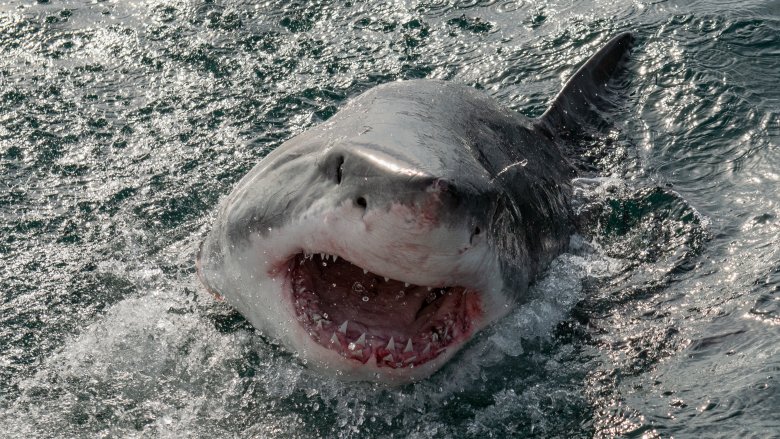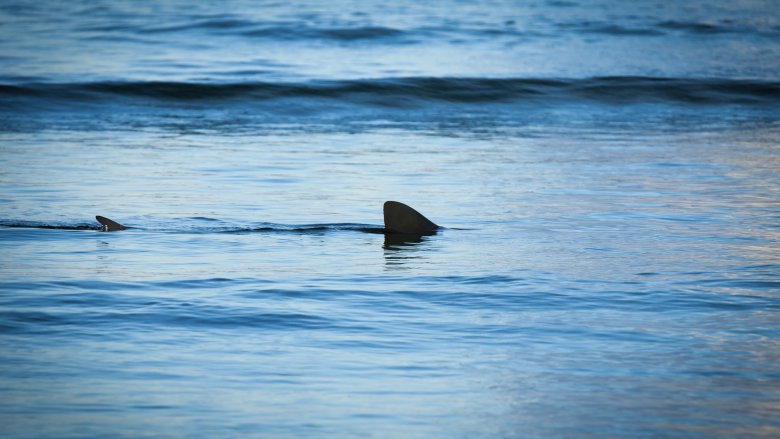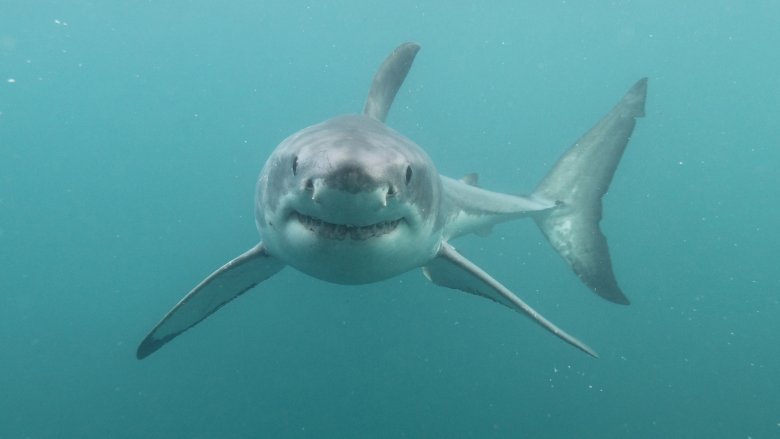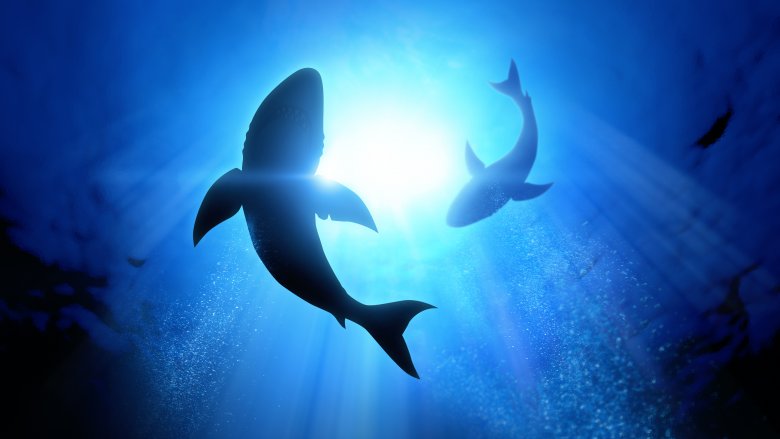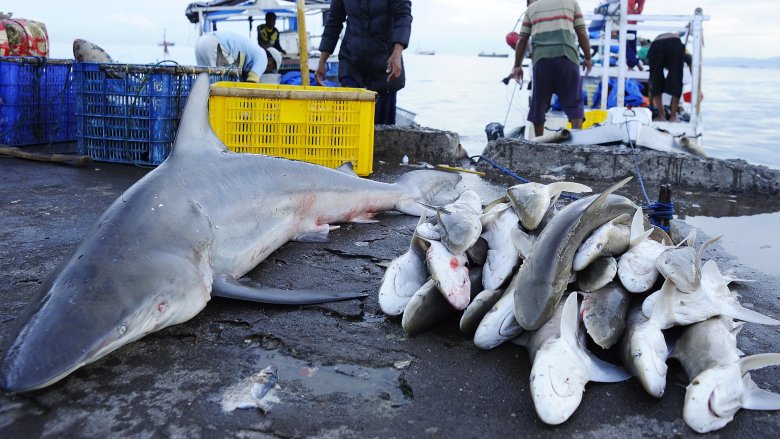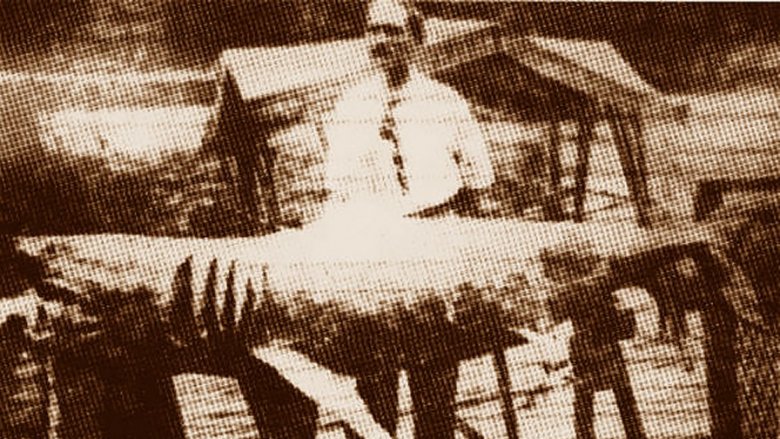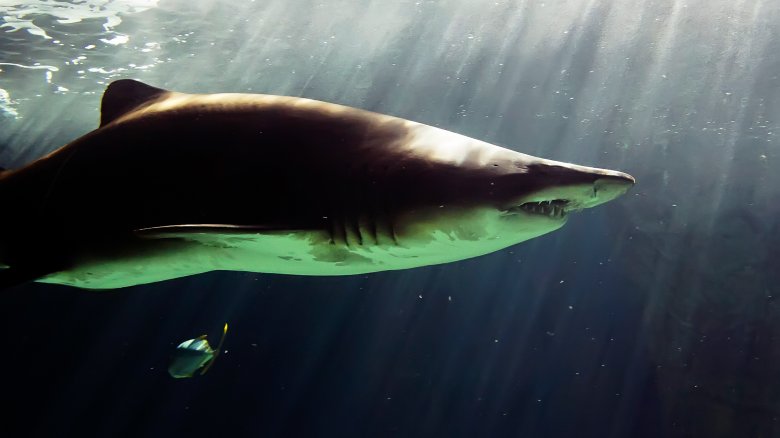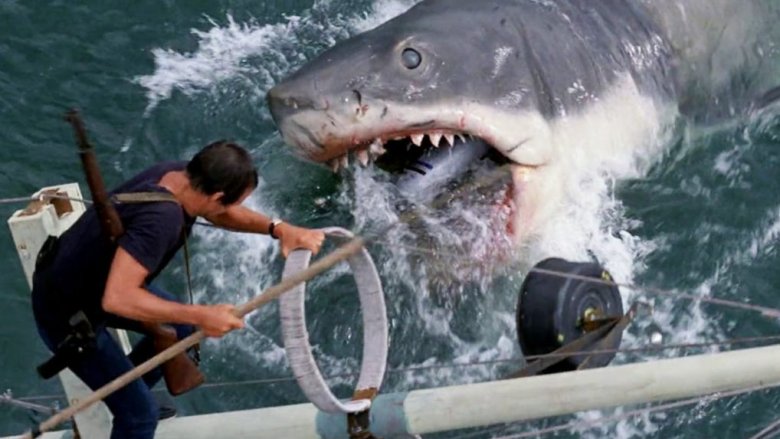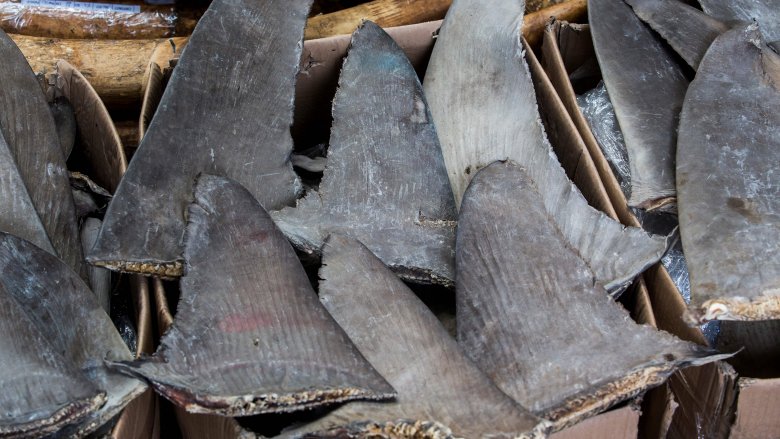The Messed Up True Story Behind Jaws
Duuun dun, duuuuun dun ... you know the Jaws theme. It's one of cinema's greatest ear-worms. Every time you go to the beach, and something gray and pointy pokes out of the water, this little musical note by John Williams shudders through your bones.
That said, while everyone knows the Steven Spielberg film, and die-hard fans remember the Peter Benchley novel that inspired it, not so many people are aware of the real-life events of 1916, which first made the world afraid of sharks. Now, to be clear, today's shark phobias are way overblown. Based on statistics alone, sharks have far more reason to be afraid of humans than the other way around. The nightmarish incidents that occurred to a little town on the coast of New Jersey in the early days of the 20th century, though, are scarier than anything the movies could ever cook up. Sometimes, the water isn't safe, and you should stick to the shore. So prepare yourself as we explore the messed-up true story behind Jaws.
In 1916, a shark attack happened
On July 1, 1916, the Atlantic Ocean hid a scary secret. That evening, an athletic youth named Charles Vansant stepped out onto the shores of Beach Haven, New Jersey. It was a normal day, a normal beach, and as Vansant waded through the shallow ocean waves — less than four feet deep — he probably barely noticed the dark fin cutting through the water. The shark, though, noticed him.
The sharp-toothed fish snapped its jaws around the young man's left leg. Vansant screamed, but according to the BBC, people thought he was joking. Blood poured into the water, and by the time a crowd of bystanders were able to pull the mutilated Vansant away from the killer shark, his injuries were too severe for treatment. Soon afterward, the young man bled to death. At the time, when the doctor's autopsy revealed that Vansant had perished from a shark bite, nobody believed it. Back then, it was the common belief that sharks weren't capable of hurting people, and that any claims of them doing so were just tall tales.
That day, the young man's tragic death became the first recorded incident in U.S. history wherein a shark killed a human. It wouldn't be the last.
Another death soon followed
Five days later, tragedy struck the Jersey Shore once again.
According to National Geographic, the next victim of a shark attack was another young man, Charles Bruder, a bellhop who'd recently come from Switzerland. As reported on the July 7th, 1916 front page of The Plainfield-Courier News, Bruder was known to be a skilled swimmer, and he'd paddled about 100 yards offshore when, out of nowhere, he broke out in cries for help. Two captains were eventually able to haul the boy onto their boat — by this time, the water surrounding him was stained dark red — only to find that both of his legs had been eaten off by a shark.
The captains raced the dying Bruder back to land, but it was already too late. He, like Vansant, died from his wounds. By this point, the media took notice. Patrols were launched. The fact that two otherwise healthy young men had been murdered by a fish, in the span of a week, wasn't normal.
Nobody really believed that sharks were dangerous
In the 21st century, where YouTube clips of great whites are just one click away, everybody is at least slightly afraid — and mesmerized — by sharks. Back in 1916, though? Bizarre as it sounds, the world thought sharks were harmless. Sure, cranky old sailors told stories about shark attacks, but nobody believed them. Even when the boys were killed, the Philadelphia Public Ledger ran a headline saying "Bathers Need Have No Fear of Sharks."
As History explains, sharks were considered shy, avoidant creatures that might've had sharp teeth but certainly didn't possess the jaw strength to take chunks out of a human being. Even when Vansant and Bruder were killed, experts dismissed the whole "man-eating shark" theory. Instead, they blamed a killer whale, a massive tuna, or ... uh, a raging sea turtle. Yes, evidently, the people of 1916 truly did consider turtles and tuna to be scarier than sharks.
One key reason behind the lack of shark concern, according to National Geographic, was that back in 1891, a wealthy athlete named Hermann Oelrichs had publicly offered a hefty sum to anyone who could prove sharks dangerous. Oelrichs even "proved" his point by jumping in the water with a shark and egging it on, only to escape unharmed. Not the most scientific method, eh? However, when the Jersey Shore attacks happened in 1916, scientists cited Oelrichs' stunt as evidence against the shark attack theory.
The violence escalates
Of course, the killer shark itself didn't know, or care, whether people believed in it or not. The following week, a preteen boy named Lester Stillwell and his friends took a swim in New Jersey's Matawan Creek, which — at over a mile from the closest bay — was pretty far from anywhere you'd expect to see sharks. According to The New York Times, Lester called out, "Watch me float, fellas!" just moments before the bloodthirsty animal flung forward, clamped its teeth down upon the boy's arm, and pulled him underwater. National Geographic says that the other boys scampered out of the creek, and took off running through downtown Matawan.
At first, nobody listened to their cries for help. After all, Stillwell was known to have seizures, and besides, they figured that sharks couldn't kill people. One man, though, did listen. The tailor Watson "Stanley" Fisher heroically marched down to the creek and tried to rescue the boy. Once there, he found the shark. As Fisher tried to pull the boy's dead body out of the stream, the shark chomped down on Fisher's leg, tearing out ten pounds of flesh. Fisher escaped from the water, but this mortal wound ended his life.
Sadly, the carnage wasn't over. The shark disappeared beneath the surface, and a half hour later, it was reported that another boy had been bitten. This kid, a 14-year-old named Joseph Dunn, was lucky enough to survive.
This wasn't normal shark behavior
As The New York Times points out, the shark that menaced New Jersey's locals back in 1916 was no ordinary animal. It behaved like a methodical serial killer, ripping into victim after victim and swimming through waters that no shark would usually ever be seen in. While this sort of violent conduct — making five attacks over the course of a few weeks — closely resembles how the shark in Jaws operated, it's really abnormal for a real shark to act this way ...
In fact, it was so abnormal that no shark has ever behaved this way again. Sure, there have been times where a rogue shark attacked a few people. However, sharks never get mixed up in the kind of nonstop insanity that this New Jersey one (allegedly) did, because it's not a practical way for them to operate. It's conceivable that the shark may have been starving, but even so, why would it keep going after such difficult prey? After all, the ocean's got plenty of fish to eat.
Jersey fights back
By this time, the Matawan locals had seen two of their people killed and one injured, so they were no longer debating whether or not a shark was responsible. The man-eating shark was obviously real, and they wanted the creature dead.
According to History, the town of Matawan went to war against the shark. A $100 bounty was placed on the animal's head. Raging mobs of locals waded into the water, desperate to take down the animal that had preyed upon them. Many wielded pitchforks, others brought spears, some fired their shotguns, and the truly furious ones tossed live sticks of dynamite right into the creek. Meanwhile, according to The Vintage News, a crew of vigilante shark killers went patrolling the coastline in loud motorboats, killing any sharks they could find. It's estimated that hundreds of innocent sharks were murdered in these hunts, none of which — most likely — had anything to do with the attacks in the creek.
The White House gets involved
News of the deadly shark attacks rushed down the East Coast, and — like a game of telephone — became exaggerated to the point where the populace came to believe that an entire swarm of sharks was threatening New Jersey, according to stories compiled by The Vintage News. Soon, nobody from New England to Florida wanted to step foot into the water, due to fears of a shark chomping down on them.
The panic eventually spread to Washington, D.C., knocked on the doors of the White House, and President Woodrow Wilson took notice. Wilson, a former governor of New Jersey, became deeply concerned about the deaths — and, most likely, his reelection campaign — so, according to The Providence Journal, he called for an emergency cabinet meeting. Following these discussions, the U.S. government decided to lend New Jersey federal aid to get rid of "all the ferocious man-eating sharks," according to National Geographic. Sharks became public enemy number one, and soon afterward, The Washington Post ran the headline "U.S. War on Sharks." The days of sharks being considered harmless had become ancient history.
The shark is caught (maybe?)
Considering that sharks were getting slaughtered up and down the Jersey Shore, it's understandable that you might ask if, or how, the authorities ever knowingly caught the actual perpetrator.
The answer? According to the Courier-Post, it's complicated. What did happen, for sure, is that a taxidermist named Michael Schleisser — who also tamed lions for the Barnum and Bailey circus — went hunting for the killer shark. On the same morning that Woodrow Wilson was stirring up shark phobia, according to History, Schleisser caught sight of a shark fin in a dragnet he'd cast in Raritan Bay. He slammed the creature over the head with a broken oar handle, over and over, until it was dead. This seven-and-a-half-foot long juvenile great white, which Schleisser later mounted for his collection, was proclaimed to be the murderous fish that killed the boys.
If you're wondering what the evidence was, well ... for one, the attacks stopped, so that's something. Two, when Schleisser's shark was cut open, The Providence Journal reports that 15 pounds of human remains spilled from its guts. For most people, this was all the convincing they needed.
Did they really catch the right shark?
Schleisser's catch tied up the story with a nice, neat ribbon. Shark found, shark killed, shark has human remains in its gut, presto. By the time World War I broke out the following year, everyone was too distracted to think much about scary fish.
These days, though, many details surrounding the Jersey Shore shark attacks have come under question, according to the ReefQuest Centre for Shark Research. For one, experts doubt that the man-eating shark was really a great white. Not only would it be utterly bizarre for a great white to swim up a freshwater creek, but these animals rarely appear in New Jersey waters, period. More likely, the animal must've been a bull shark, which raises the question of whether Schleisser caught the right fish, after all. As for the human remains in its belly, well, the shark could've easily scavenged a drowning victim's corpse at the bottom of the ocean. It happens.
There's a bigger hole in the common narrative, though. The whole "rogue shark" theory, which blames a single serial killer shark for all five deaths, could be total hogwash. As previously stated, sharks never behave that way. Furthermore, the first two shark attacks on Vansant and Bruder happened 70 and 25 miles away from Matawan Creek. That's a whole lotta swimming for Mr. Rogue Shark. These days, experts have proposed that the 1916 attacks might've been from three separate sharks, not one.
How did the attacks influence the story of Jaws?
The 1916 New Jersey shark attacks garnered a lot of media attention and made generations of beach-goers afraid of the water. Not surprisingly, the hysteria that followed these incidents is often cited as the chief inspiration for Peter Benchley's 1974 thriller novel, Jaws, which went on to inspire the blockbuster Steven Spielberg film. It's easy to see why. The storyline of Jaws often directly parallels the real life events of 1916, and the rogue shark — whether real or imagined — is the only such animal that has ever behaved like the book/movie's fishy antagonist.
Strangely enough, Benchley has claimed that his book was not inspired by the New Jersey attacks. Now, you can't really argue with the author, since he knows what he wrote and why he wrote it. However, it's also hard to imagine that the 1916 events didn't at least subconsciously inspire Benchley's work, even if they weren't a conscious influence. And hey, that's the nature of creativity. All the things you see and hear, as you go through the world, seep into your art in odd and unexpected ways. The key element here, as suggested by NJ.com, is that the cultural fear of sharks in the U.S. today stems directly from the 1916 attacks, so if these tragic events hadn't occurred, Jaws wouldn't have existed ... and most likely, neither would Deep Blue Sea, The Reef, or (sigh) Sharknado.
Over 40 years after Jaws, the town still remembers
It's been a long time since Jaws and an even longer time since 1916, but you can't live in a town where a kid got brutalized by a shark in the local creek and not shiver about it. In 2016, on the 100th anniversary of the deadly shark attacks, the sleepy little town of Matawan, New Jersey, held a nine-day commemorative event in memory of those who'd died. According to The New York Times, the influx of tourists was a huge change for a town that normally only has a population of 9,000 people.
The hero of the event was the deceased tailor, Stanley Fisher, who so nobly lost his life trying to save the preteen Lester Stillwell from the jaws of death. A special memorial service was held at the graves of both Fisher and the boy, and a new monument in Fisher's honor was unveiled. In attendance was Fisher's great-nephew, John S. Nichols, and his family. Today, Nichols is a professor emeritus at Pennsylvania University. He claims that, before Jaws came out, nobody believed what had happened to his great-uncle. He also says that whenever Shark Week returns to the Discovery Channel, neighbors offer their condolences on his loss.
The story of Jaws has made us way too afraid of sharks
While shark encounters can become deadly, and you should definitely get out of the water if you see one, it's also important not to villainize these poor creatures. Sure, they're capable of tearing apart humans. Yes, they look scary. But honestly, the true story behind Jaws has made us way too afraid of sharks. After all, they're not serial killers, monsters, or demons. They're just hungry fish.
As Business Insider points out, sharks almost never make unprovoked attacks. For example, if you look at the near-century that transpired between 1916 and 2011, the dreaded great white only attacked 106 Americans, unprovoked, with only 13 of these attacks proving fatal. That's not a big number. Truthfully, sharks don't enjoy eating humans. People don't taste good, evidently. Even when sharks do attack humans, it's almost always a "hit and run" incident, wherein the shark bites down, hoping for a delicious seal, then realizes that it instead nabbed a nasty human, and simply swims away.
Now, as the 1916 attacks prove, there are vicious sharks in the world. You know what else is out there? Vicious cats, vicious dogs, and vicious humans. If anything, a 2013 study showed that sharks have a lot more to fear from humans than the other way around, given that people were estimated to kill between 63 and 273 million sharks a year. Statistically, it's far more likely that you'll eat a bowl of shark fin soup, as opposed to a shark eating you. So hey, take it easy on the sharp-toothed ones.
